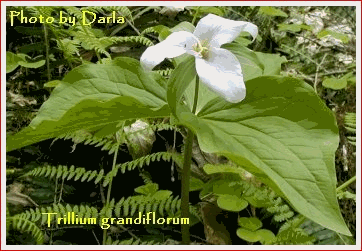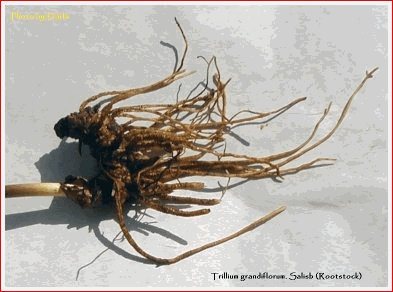
 TRILLIUM.
N. F. [Beth Root]
TRILLIUM.
N. F. [Beth Root]
United States Dispensatory 1926
Compiled and Edited by Ivor Hughes
United States Dispensatory 1926
TRILLIUM. N. F. TRILLIUM Trill. [Beth Root]
"Trillium consists of the dried rhizome and root of Trillmm erectum Linne and other species of Trillium (Fam. Lilaceae}. Trillium contains not more than 2 per cent of foreign organic matter." N. F.
Beth Root; Birth Boot; Wake Robin.
The trilliums are attractive native lilies easily recognized by their stout simple stem which bears at the summit a whorl of three broadly ovate leaves and a large terminal flower. The flower which appears in late spring, in the official species, is composed of three herbaceous sepals and three larger ovate petals usually of a brownish purple color. The fruit is a three-celled, six-angled red berry. The commercial supplies of this drug are obtained chiefly from North Carolina, Virginia, Indiana and Missouri.
Description and Physical Properties. � " Unground Trillium.�Rhizome oblique, globular, oblong or obeonical, truncate below, terminated at the top by a small bud surrounded by a sheath of scarious leaf bases, annulated by leaf scars and fissured by stem scars; from 0.6 to 5 cm. in length and from 1 to 3 cm. in width, more or less compressed laterally; rootlet scars in several concentric rows on the under side in the upper portions; externally yellowish to reddish brown; internally of a pale yellow; fracture somewhat uneven with a hard and close texture or a more or less spongy appearance. Odor distinct; taste bitter and acrid with a sensation of warmth in the throat, and when chewed causing an increased flow of saliva.
"Powdered Trillium. � Pale yellowish white; consisting chiefly of fragments composed of parenchyma some of which are elongated and contain raphides of calcium oxalate up to 0.225 mm. in length, others being nearly isodiametric, more or less thin-walled and containing mostly simple, nearly spheroidal altered or unaltered starch grains, the latter up to 0.020 mm. in diameter; fragments of epidermal tissue composed of cells with reddish brown porous walls; tracheae with spiral or reticulate markings." N. F.
Reid (A. J. P., 1892, p. 67) found in trillium 4.86 per cent, of a saponin, also an acid crystalline principle which gave a purplish brown reaction with sulphuric acid and a light green with sulphuric acid and potassium dichromate. Prendergast (Am. Drug., Nov., 1886) believes that there is present a glucoside similar to eonvallamarin. The drug also contains volatile oil and an astringent principle, probably a tannin.
Uses. � The term birthroot appears to have been applied to this
substance by the early settlers because of the fact that the American
Indians used it as an aid to parturition. From this aboriginal use the early
settlers came to employ the drug in the treatment of various uterine
disorders, as metrorrhagia and menorrhagia. It is also
employed in the treatment of various hemorrhages both locally and
internally, and as an astringent in diarrhea. It is today, however, almost
never employed except as an ingredient of the compound elixir of viburnum.
Dose,
one-half to one drachm (2-4 Gm.).
Off. Prep. � Elixir Viburni Opuli Compositnm, N. F.; Fluidextractum
Trill, N, F.

![]()